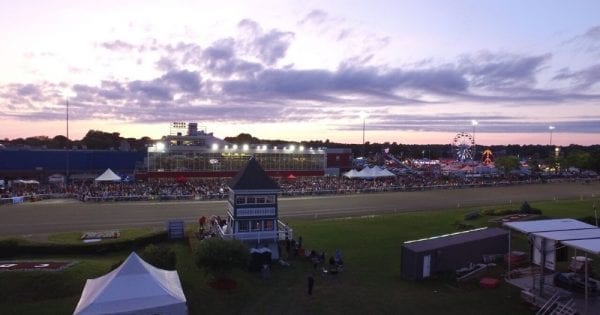Drones at Old Home Week
How Curtis MacDonald and Red Shores Charlottetown put harness racing in High Definition.
by Melissa Keith
It’s often said that harness racing is resistant to change. Fortunately, Curtis MacDonald never got the memo. The Cujo Entertainment videographer is based in Guelph, ON, but turned to his home province and one of Canada’s most historic racetracks to introduce a potential game-changer in 2015.
Curtis is a member of the well-known PEI racing family that includes his brothers, reinsmen Mark, Anthony, and Canada’s representative in the 2017 World Driving Championship, James. Their mother, Gail, shares duties as track photographer at Red Shores Charlottetown.
“I’ve always been in the broadcast industry, and Ajax Downs (a quarter horse track in Ontario) started using a drone, every now and then, for special event days. I really liked the way the imagery looked from it,” he said. “So I went out myself and bought one.”
MacDonald’s cousin, Scott MacLean, is one-half of the Universum Media team, which produces the Red Shores Charlottetown “Race Day” simulcast show. Curtis said he first asked MacLean about steaming live video from his drone for the 2015 Old Home Week simulcast. “He said he would run it by (Red Shores marketing manager and simulcast host) Lee Drake, and Lee was like, ‘Yeah, for sure! Let’s try it out.’”
The experiment took place under well-controlled conditions, albeit in a province renowned for its traditional ways. Drones have had a limited role in North American harness racing videography to date, although their use made headlines last November, when the Alcohol and Gaming Commission of Ontario hired a private operator to stream and record select qualifiers from The Raceway at Western Fair District. The AGCO’s pilot project was intended to assist racing officials, not provide public entertainment.
Red Shores Charlottetown and MacDonald would prove an optimal match for a test flight during one of North America’s best-attended racing events. “I understand the dos and don’ts around horses,” said Curtis.
Despite widespread popularity of drones, non-professionals are prohibited from bringing them to racetracks. MacDonald noted that even with his professional experience and local connections, he wasn’t exempt.
“To be flying over the racetrack, you need written permission from the racetrack, and you have to have permits with Transport Canada. If you don’t have either one of those things, then you’re flying recreationally, which you’re not allowed to do over an open-air event like that. You have to keep 500 lateral feet from any spectators or anything. You couldn’t even be on the premises if you kept 500 lateral feet away.”
MacDonald’s Old Home Week drone is a DJI Inspire One professional model. He said that due to proximity of Charlottetown Airport to Red Shores, the first year he applied to fly it above the racetrack infield, there was extra paperwork involved. “They recently changed this, but on the day of the event, you had to contact the control tower at Charlottetown, because you’re within three kilometres of the airport. I think it’s approach path ‘B’ you’re actually on.”
He noted that the altitude of his drone isn’t comparable to that of aircraft. “So it’s not a big deal — they’re just aware that I’m in the air.”
Responsible operation involves a “spotter” to help monitor the device’s every move. For Old Home Week 2015 and 2016, Curtis said his wife, Jaimi, worked alongside him.
“I’m watching the screen, seeing how the shot looks; she’s got her eyes on the drone, just in case of something like coming close to a light pole. Those are really the only obstructions at Charlottetown.”
Major outdoor events are inappropriate settings for amateur videographers to break out the drones. Recently, while working at PEI’s Cavendish Beach Music Festival, MacDonald said he saw two “rogue drones” flying near his own. Festival organizers were swiftly notified, then the RCMP. “They knew what mine looked like, and I landed right away.”
The 2015 Gold Cup and Saucer final will always be remembered for the torrential rains that saw it delayed, cancelled, and rescheduled for the following afternoon. “The drone that I have isn’t designed to fly in the rain, so I wasn’t going to fly in the rain at all,” said Curtis. “When (horses) came out for post parade, I had Jaimi watching the radar on my phone, because I knew it was coming, and coming fast.”
“I had to land anyway, because they were turning all the lights out. So I landed, and then it just came down like cats and dogs.”
It wasn’t the first time Curtis had dealt with adverse conditions. He assists his brother, trainer/driver Anthony, with live coverage of training days for young horses owned by “The Stable” fractional ownership group. “We actually started mid-winter last year. We were streaming every second Saturday, when I was there with the drone. We were livestreaming it; there were roughly a thousand people viewing the live drone days,” said Curtis, adding that The Stable’s “Spring Showcase” drew an online audience of around 3,500 viewers.
While rain posed no complication to The Stable’s livestreaming, drones are sensitive to other climactic conditions. “A couple of times this winter, we had to cancel the drone days, because it was just too windy, or if it got really too cold, Anthony wouldn’t want to be out there training his horses anyway,” said Curtis. “The battery is the main thing — if I go out and it’s -20 (Celsius), I’m probably only getting about 10 minutes out of the battery.”
According to Curtis, the unexpected, formerly unattainable, vantage points of drones bring a freshness of perspective. “I think it’s a shot that’s different,” he said. “For the last 40 years, let’s say, that they’ve been recording horse racing, it’s always the same shot — it’s a pan shot from the side of the grandstand… Last year at the start of the Gold Cup and Saucer, where I followed [horses] through the turn, I wasn’t right over them, but it had the illusion that I was right over top of them when the gate let go… You never see that kind of shot.”
Inclusion of drone video in live 2015 Gold Cup and Saucer race coverage appears to have been an unofficial first in Canadian harness racing. “When you do it, you always get comments on social media — people are blown away by how it looks, how Charlottetown seemed to be the innovator to do this — take a live drone feed, and put it into their broadcast. Nobody else had done that, up to that point,” said Curtis.
When he submitted a photo captured using his Inspire One to the O’Brien Media Excellence Awards, it didn’t win, but it helped further the acceptance of drone photography. “You still have to have an ‘eye’. The drone is flying in the air, but you have to be able to compose the shot.”
Curtis confirmed there won’t be drones overhead at Gold Cup and Saucer 2017. “Of all years to be 10 days away from giving birth to our first child, it happened to be the year that James is there on Friday night for the World Driving Championship,” he said. “I’ll be at home in Guelph watching it, cheering him on.” He added that he hopes to be invited back to resume low-altitude aerial coverage next Old Home Week, as drones are no passing trend.
“It wouldn’t surprise me in the least if Hoosier Park had a drone for Breeders Crown,” he said. “It’s just a shot like no other.”

















